Soldiers
journey from the USA to Vietnam
(1) Initial Deployment of the 1st Battalion 6th Infantry from
the USA to Vietnam.
In the early days of the war, entire units and their equipment deployed
to Vietnam by military ships.

In this photo furnished by Bruce Day, Radar, 1-14th Arty 1967-68, trucks
prepare for shipment
from Fort Hood, Texas to Vietnam. The unit provided 105 mm howitzer
fire for the 1st Bn 6th Inf.

Soldiers from the 1st Bn 6th Inf make final preparations at Fort Hood,
TX prepare to leave for their
trip to Vietnam aboard the USNS Upshur. Photo furnished by Tony
Hall, HHC/1-6 Inf 1967-68.

Navy photo of the U.S. Naval Ship Upshur (AP-198). Operated by
a merchant marine civil service
crew under the Military Sea Transportation Service (MSTS), the ship
originally was built for the
American President Line (MC 2916, President Hays). The 11,230
ton ship was 543 ft. long, 73 ft.
wide, with a draft of 27 ft., and could carry 6,400 tons. It
had a steam turbine engine with one propeller
and was designed to have air-conditioning. [Source: Naval
Vessel Registry.] When the USNS
Upshur was transferred in April, 1973, to the Maritime Administration
(National Defense Reserve Fleet),
the troopship era came to an end. For a time, the USNS Upshur
operated as a training vessel for
the Maine Maritime Academy. Records show that it is now berthed
in Mobile, AL. For more infor-
mation about the USNS Upshur, link
here and here.
[Note: some other units in the 198th Inf Bde
deployed to Vietnam at the same time in 1967 on the USNS General Gordon
(AP-117) shown
below on a postcard provided by Howard Walker].

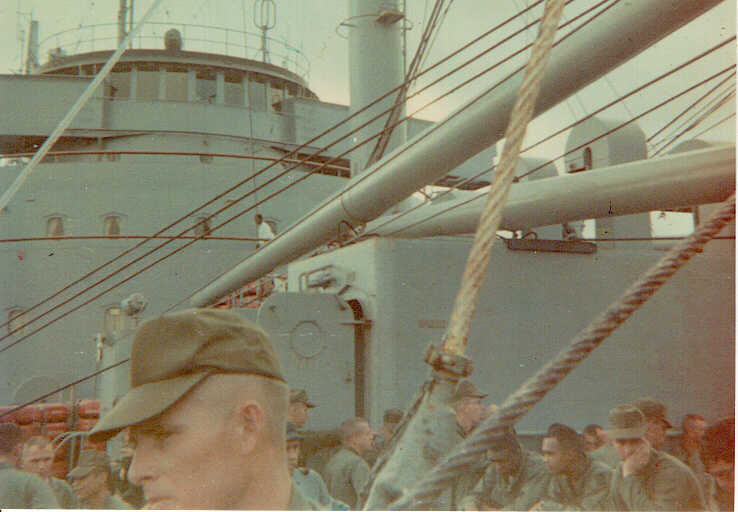
During the voyage on the USNS Upshur there was plenty of time to sit
and think, or to engage in some crazy Navy tradition with the Golden Dragon
at the 180th Meridain international date line. Photos from Don Kaiser
and Tony Hall. |
 |
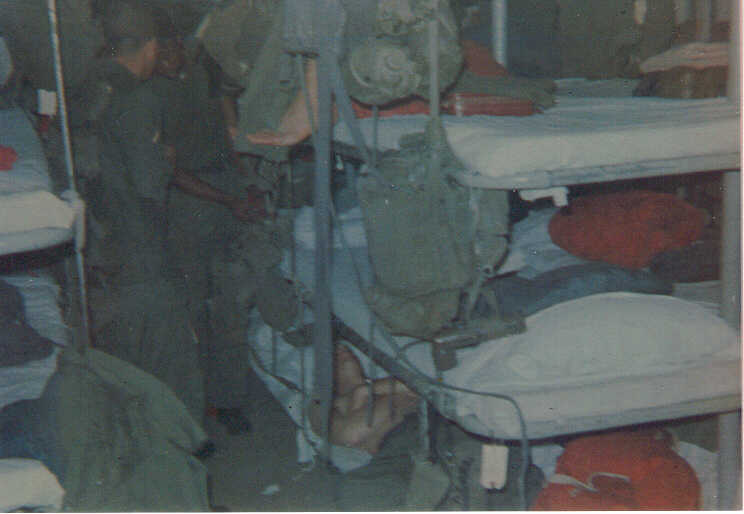
The USNS Upshur had two large holds forward and aft, with accommodations
for 416 officers and
1748 enlisted men. Note the close quarters for sleeping -- the
Navy way. Do not sit up quickly!

While onboard ship, the soldiers were expected to keep fit. The
"daily dozen" workout helped.
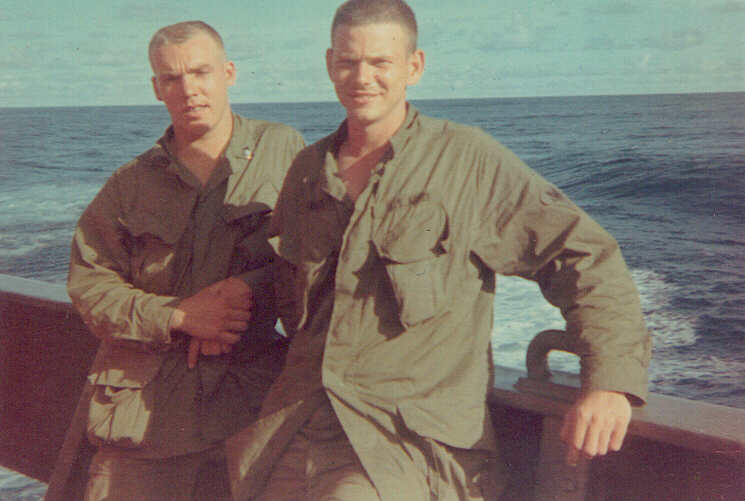
Don Kaiser (on left) provided these photos on the USNS Upshur.
Not every day at sea was placid. When the wind blasted across the
Pacific, some of these "Regulars"
from the 1st Bn 6th Inf looked a bit green. They were to learn
in only a few months that they were
indeed green troops-- new to the realities of war. Within a year,
over 100 of the approximately 550
soldiers from the 1st Bn 6th Inf would be dead. B&W from
Tony Hall; color from Don Kaiser.

The USNS Upshur slowly approached these docks on the way to Vietnam.
Don Kaiser in photo.

On 22/23 October 1967, soldiers from the 198th Infantry Brigade debarked
from LSTs
at Chu Lai.
In this US Army photo provided by Dave Ross, HHC 67-68, soldiers from
the 1st Bn 6th Inf stand
arrayed behind the 198th Inf Bde colors.

From left to right, BG S.W. Koster, COL ? the 198th Brigade Commander,
and General
Westmoreland, COMUSMACV. BG Koster assumed command of the 23rd
Infantry Division
(AMERICAL) upon its activation on 25 Oct 67, and was promoted to MG
(Brevet) on 26 Oct 67.
The soldiers shown here are from the 1st Battalion 6th Infantry.
Black and white photo furnished
by Howard Walker, the soldier clearly visible at the head of the file
on the right.

The units began in-country training in the Duc Pho area of operations
at Carenten (BS 843 871),
shown in this photo provided by Tony Hall, HHC/1-6 Inf 67-68.
By 26 November 1967 the unit
finished training and had completed movement to Chu Lai to begin combat
operations in the
surrounding tactical area of operations.
(2) Later Deployment of Replacements
The policy for the Vietnam War was that soldiers would be rotated back
to the USA after
their one year tour. Thus, individual replacements were needed
for combat losses and rotation.
Individual replacements arrived in Vietnam after traveling by military
chartered commercial aircraft.
Most arrived at Bien Hoa Air Base near Saigon with only issue uniforms
and no equipment or weapons.
The air routes to Vietnam varied--some flew by way of Johnston Island,
while others landed briefly
in Hawaii, Alaska, the Philippines, or Guam before completing the long
journey of twenty hours or
more. Photo below furnished by Al Simms, Radar Section, 1st 14th
Arty, of a typical charter flight
by Continental Airlines-- many new and a few back from R&R.

After taking off their khaki uniforms and donning new jungle fatigues
and jungle boots, the troops
going through in-processing were ready for their assignments to units
"upcountry."
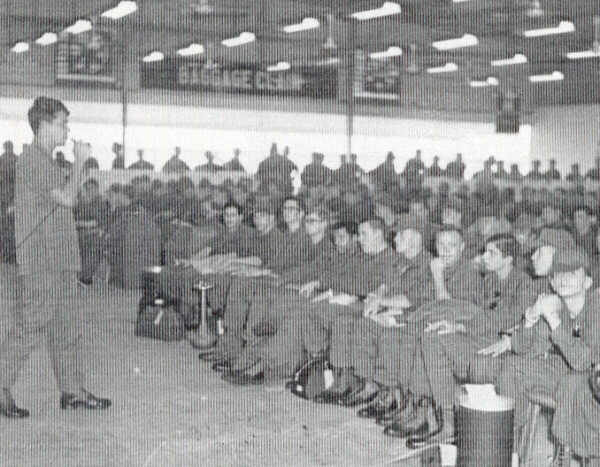
Scan of photo CC 64735, Still Picture Reference, National Archives
II, College Park, MD.
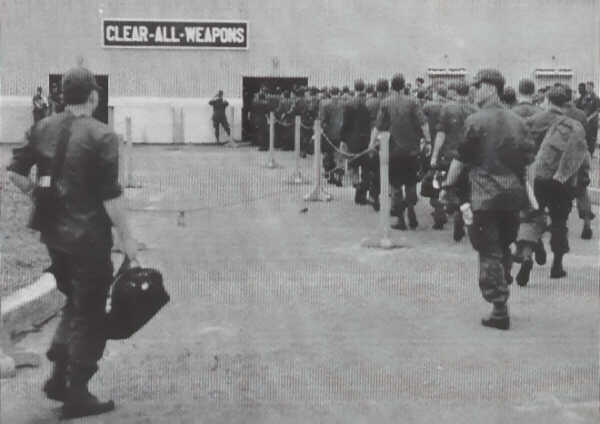
Scan of photo CC 64734, Still Picture Reference, National Archives
II, College Park, MD.
Only "365 and a wakeup" remained for these new soldiers until the hoped
for DEROS (Date Estimated
Return from Over Seas) to "the land of the big PX" -- the "good old
USA." After a year or more of
service in the war, many would experience the "whooping and hollering"
of elation and thankfulness
that characterized the final takeoff from Vietnam. But many came
home in a box.
While the web master, a "newby" at the time, was waiting at Bien Hoa
for a flight on an Air Force C-123
to Da Nang, a flight came in from up-country. Twenty or so of
the roughest, toughest, and dirtiest
soldiers one can imagine got off. Their uniforms were in tatters
and they were armed to the teeth. They
were overloaded with more weapons, ammunition, and grenades than one
could imagine. Obviously
someone forgot to tell Fort Benning that the basic load for each weapon
in Vietnam was about three
times that specified at the Infantry School. And the next generation
of new infantrymen arriving for the
war would soon realize that they had better pay attention to those
who had learned to how to be
aggressive to survive.
Select additional photos from the index at left or link to the 1st Bn
6th Inf Home Page